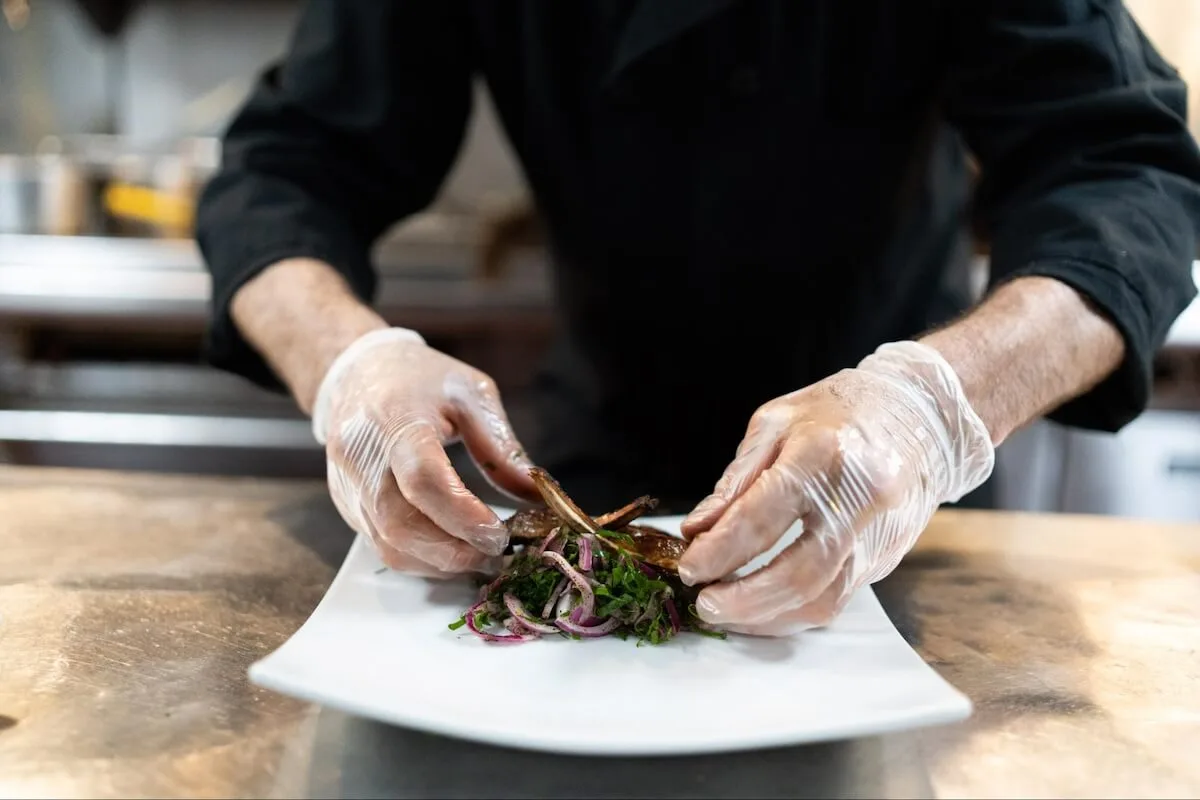11 ways to boost your restaurant profit margin in 2025
Whether a restaurant owner went into the food service business due to a love of food, an entrepreneurial spirit, or as a bucket-list item, there’s no avoiding the reality of the bottom line: Profitability means survival. Maximizing restaurant profit margins can mean the difference between a successful business and a failed one.
We’ll help you figure out what you need to know to increase your restaurant’s profit margin. We’ll provide context for the restaurant industry in general and specific steps a restaurateur can take to boost their numbers.

The basics of restaurant profit margins
At its most basic level, restaurant profit can be measured in two ways: gross profit and net profit.
Gross profit is total revenue minus the cost of goods sold (COGS). Net profit is gross profit minus all other operating expenses, including labor costs, rent, and all other overhead costs.
Take, for example, a hypothetical restaurant that earned $100,000 in total revenue and whose COGS was $50,000. The resulting gross profit margin would be 50%.
Net profit takes everything else into account. So, with this same hypothetical restaurant, let’s say their operating expenses were $30,000. That would leave them with $20,000 remaining or a net profit margin of 20%.
Average restaurant profit margin
A typical net profit margin for full-service restaurants will likely be in the single-digit range and maybe toward the low end at that. Quick-service restaurants and caterers may approach 10%, but reaching double digits is a significant milestone.
Countless factors go into a restaurant’s profit margin, not least of which are the models found in different types of restaurants.
For example, fast-food restaurants typically have higher profit margins than full-service restaurants because of their business model and economies of scale. Still, there’s even significant variation in that world. In 2024, McDonald’s had a profit margin of around 32%. At the same time, Wendy’s had a profit margin of around 9%. Clearly, there are plenty of variables at play.
Any restaurateur will want to boost their profit margin as much as possible. Let’s look at ways to do that.
Get to know your metrics

One of the best ways to improve your profit margin is to investigate and understand your restaurant’s metrics. Reliable data allows for rational, informed decision-making that can lead a restaurant to higher profitability. Making any strategy to improve profits without understanding the mechanics of a business is just a shot in the dark.
A restaurant’s metrics are often called key performance indicators (KPIs). One such crucial KPI is COGS. Understanding your COGS clarifies how much your inventory costs. To find this number, simply subtract the value of your inventory at the end of a given period (a day, a week, a month, etc.) from the value at the beginning of that period.
Combining your COGS with your inventory turnover ratio can give you a leg up on inventory management. You can find your inventory turnover ratio by dividing your COGS by your average inventory value over a long period of time, like a month or a quarter. Then you’ll know if you’re stocking the right amount, which helps reduce food waste.
You should also know your food cost percentage or how much a menu item costs you compared to its menu price. A typical rule of thumb is that the menu price represents around three times the typical food cost, though food costs can vary 20-40% depending on several factors. Understanding your food costs can help you set reasonable pricing structures to make sure both you and your customer are getting a fair shake.
Menu item profitability describes how much profit a menu item brings, but many factors besides its cost-to-price ratio determine profitability. How long does the dish take to prepare? How quickly do customers eat it? High-profit items are not always the ones that have a low food cost percentage.
Good point of sale (POS) systems and other restaurant software will be able to help you figure out other crucial metrics, like revenue per seat, table turnover rate, and more.
Built-in costs
Before you improve your profit margin, you’ll also need to be familiar with other parts of your total expenses including your overhead costs and labor costs. Overhead expenses cover all costs besides labor, including rent, utilities, insurance, and so on. As a good guiding principle, labor costs are best kept below 30% of revenue if possible.
11 ways to maximize profit margin
Once you’ve fully equipped yourself with the knowledge necessary to understand the nitty-gritty of your business, you can adopt strategies to boost your restaurant margins.
Increasing total sales is one of the most direct ways to improve your profit margin. A savvy restaurateur can take many approaches, but here are 10 successful strategies that increase sales.
1. Build a strong social media presence
Social media is a must for restaurants in this age. After all, consumers read restaurant reviews more than reviews of any other industry. A whopping 84% of people trust online reviews as much as personal recommendations. Restaurants have taken note: More than 60% of restaurants invested in digital or location-based marketing in 2024, the highest investment of any tech category. Put that together and you have an overwhelming case for a strong digital presence.
Smaller or new restaurants can help define their brand voice by using creative posts to promote their business locally. High-quality food photos are an especially crucial aspect of restaurant marketing.
Restaurants can now use Yelp’s booking links to share on social media. These unique links take customers directly to your reservation page, meaning it’s simpler than ever to get your name out there and fill your tables.
2. Be active on online review sites
Responding to customer reviews—both good and bad—is an excellent way to engage with customers and help build a repeat customer base. You can turn a negative review into a positive experience by addressing a customer’s complaints, for example, and suggesting a way to remedy the problem. Keeping track of reviews and ensuring a positive customer experience can make a successful restaurant out of a struggling one: The overwhelming majority of customers will trust a business with a rating higher than 4 stars, but below 3 stars the numbers drop off quickly.
Personalize the experience for Yelp users with Yelp Connect. Connect lets you share stories Instagram-style with your demographic, bringing your business to life with real-time updates. Optimizing your online reach is made simpler with analytics, which let you see who’s engaging with your posts, helping you to narrow down your audience.
3. Make sure your online ordering and takeout options are robust
If you rely on third-party delivery services, check to ensure their commission doesn’t cut into your menu item profitability too much. In some cases, where margins are razor-thin, delivery of certain items may mean the restaurant breaks even at best. In such a case, it’s best not to deliver at all since valuable kitchen time is wasted on an unprofitable item.
Fast-casual restaurants have been able to take advantage of the upsurge in third-party delivery apps since they’re already built for volume. This is as opposed to full-service restaurants, where the dining experience is more important than volume of customers. If you’re running a fast-casual restaurant, you can boost your profits simply by boosting your sales.
If you need help on the technology side of things, combining Yelp Guest Manager with a POS system makes managing takeout orders a seamless experience.
4. Create a loyalty program to help attract and retain regular customers

A loyalty program should reflect the values and style of the restaurant, and there are countless ways to implement such a program. For example, it makes sense for a quick-service restaurant or food truck to offer a tenth burrito or smoothie free on a rewards card. However, the same strategy would cheapen the appeal of a fine-dining restaurant, which may be better served by offering free wine pairings or desserts.
Loyalty programs have come a long way in the last several years, and many services exist to offer modern restaurant loyalty programs. These can be custom-made and sync with existing customer relations management systems to automate offers and coupons for returning customers. Restaurants can now have a loyalty app made specifically for their restaurant, for example, paid as an affordable subscription fee. We’ve come a long way from punch cards.
5. Prevent food waste with creative specials
Food waste is the bane of a restaurant’s profit margin. It’s the exact opposite, in fact: Money spent with no return whatsoever. So, finding ways to minimize your food waste is paramount to keeping your profit margins intact and making your cost of ingredients work for you instead of against you.
If you find yourself with excess product, like seasonal produce or a big catch of fresh seafood, work with your chefs to design specials intended to sell those things.
Designing a seasonal menu can be a good way to keep your restaurant expenses down while selling fresh food. It also allows for flexibility in your menu items since you never know what kind of windfall sale you can come across from food distributors.
Make sure to advertise your specials on social media and via your email marketing so that loyal customers and new ones alike can try your new offerings.
6. Train staff to upsell
Upselling profitable items is a key point in a server’s job, so make sure your restaurant manager stays on the ball with training and re-training when necessary. This re-training can be especially valuable if you have a frequently evolving menu or a large drink list, including wine.
Servers should recommend appetizers, drinks, and desserts, and be able to recommend beverages to accompany meals. They don’t have to be pushy—often the suggestion is enough. Some restaurants offer rewards for servers that upsell the most at the end of the month, so consider setting up a competition to keep servers engaged.
7. Work on menu engineering (and the related data)
Designing your menu to encourage sales of your most profitable items is a wise move. This is called menu engineering, and there’s some serious science behind it.
Generally, restaurants put their most profitable or prestige items on the top right or top center as that’s where customers’ eyes gravitate first. Less profitable items generally go toward the bottom and the left.
Menu engineering is more than just optimizing your menu. Restaurateurs can track price fluctuations throughout the year and broader business cycles by keeping tabs on the individual ingredients in each dish. For example, olive oil prices more than doubled between 2022-2024, leading to significant cost increases for restaurants that use lots of it. Restaurants that don’t explicitly need olive oil in specific dishes could swap it out for a less expensive oil to improve their restaurant’s financial health.
Up-to-date inventory management software can help calculate and track the costs of ingredients so a restaurant business can make wise decisions. It takes some legwork getting started, but dialing in the details has a high return on investment.
8. Forecast the future
You don’t need a crystal ball to predict sales trends and the related inventory purchases you’ll need. Many forms of restaurant management software help with sales forecasting, which can impact both your inventory and staffing decisions.
For example, extrapolating historical sales data around holidays can show just how much extra (or less) you’ll need to purchase and how many more (or fewer) servers you’ll need to have per shift. You can look at specific days like Mother’s Day and Valentine’s Day or broader trends like the slow season or the summer.
9. Watch your portion sizes

In many cases, it seems like there’s an arms race at restaurants to see who can serve the biggest portions. It doesn’t have to be this way! If you see your customers frequently walking out with leftovers, you’re probably overserving.
While portions are very carefully controlled at both fast food and high end restaurants, those that fall in the middle may find their portion control to be a bit loosey-goosey.
Quick-service restaurants (QSRs) may find that their staff are overloading the meat in their burritos, while an Italian restaurant may be over-cheesing pizza.
While your kitchen staff don’t have to keep everything precise to the gram, establishing carefully considered portion metrics can keep costs down and profit up no matter what the restaurant type.
This applies to bars as well: Keeping pours of wine and liquor consistent can keep profits steady and predictable, even though many people love a heavy-handed bartender.
10. Optimize your staffing costs with kiosks
Utilizing emerging tech like restaurant kiosks can help minimize staffing costs and prevent confusion and bottlenecks in key areas. Fast food restaurants and QSRs can benefit from self-ordering kiosks, which are becoming increasingly popular.
Similarly, traditional table-service restaurants can support hosts with a check-in kiosk like Yelp Kiosk. Integrating Kiosk with your front-of-house software suite can streamline operations and increase table turnover rates, meaning more customers served and more profit.
While restaurants aren’t quite yet turning to robots, the numbers are incoming: About 43% of millennials and Gen Z are OK with food getting prepared by robots, but only 29% of consumers overall. Similarly, only 37% of overall consumers are OK with robots delivering their food. We’re not yet in robo-topia.
But saving money on staffing doesn’t simply mean cutting staff hours or replacing them with robots. It can also mean making service more efficient, both in the FOH and BOH. Customers are increasingly comfortable with tech solutions in restaurants—for example, 65% of customers are comfortable paying at the table using a tablet. Over time, tech solutions improve table turnover rates, leading to higher sales and higher profits.
11. Drinks can have a significantly higher profit margin than other menu items

You see better profit margins with wine and spirits for a few reasons:
- Kitchen staff doesn’t have to cook them.
- They’re relatively high-value items compared to how much storage space they take in a restaurant, where space is at a premium.
- They also take relatively little time to prepare and serve compared to most food items.
- There’s almost no waste from them, making operating costs low—liquor doesn’t go bad and wine is often sold by the bottle. Wine sold by the glass is often sold at enough of a markup to make up for most wastage.
- Perhaps most importantly, many customers find that a pleasant drink improves their dining experience in intangible ways and may leave with fond memories.
In my experience owning and operating pubs and restaurants, lowering menu prices on wine and liquor compared to competitors can lead to significantly increased sales across the board. Customers become regulars, spend more on food and drink, and invite their friends to a place they associate with fun and conviviality.
At the same time, those lowered profit margins on wine and liquor due to lower menu prices are more than made up for by increased sales volume.
Use technology to give you an edge
There is some amazing software available to restaurateurs these days, and many restaurants are leveling up their tech. The majority of restaurants are investing in tech that makes their service more efficient and their customers happier.
So, restaurateurs have an array of options in front of them—but what’s the best bang for your buck? From managing your front-of-house and reservations to helping compile detailed analytics reports, Yelp Guest Manager can make a restaurant operator’s life much simpler than before. Best of all, it can help provide that much-needed edge to boost a restaurant’s profitability. Being able to keep track of all your data in one place can help you make informed decisions.
If you’re looking to upgrade your restaurant technology, there’s no better time than now. Request a demo of Yelp’s FOH platform and see if it’s right for you.